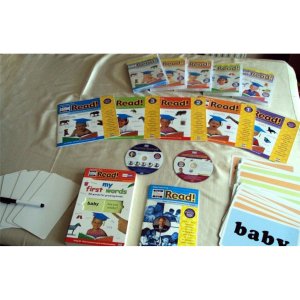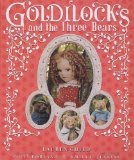
Some time ago I was asked to review ‘Your Baby Can Read’, a system for teaching babies from 3 months old to read. The system aims to introduce the written word at the same time as a baby is developing a verbal vocabulary. As today is International Literacy Day I felt I should bite the bullet and go for it.
So why the procrastination? My initial thoughts were that such a system goes against my beliefs. I have seen many parents who focus far too early on reading and writing and become both stressed and competitive about it. A baby has so much to learn in the first years is it really necessary that we add reading to the list? I also feel that a lot of the time a focus on learning to read and write means that many of the underpinning skills necessary to achieve this are overlooked. However, I felt that it was important that such products are reviewed by someone with an early education background. I was interested in seeing the products to help make an informed view.
The materials in the programme include 5 DVD’s, 5 lift the flap books, 5 sets of sliding word cards, music cd, 82 double-sided word cards, a sliding windows board book, word game cards, a parent’s guide and early learning workshop DVD.
To be honest, I liked the materials more than I thought I would. My biggest reservation about the whole programme is that reading is taught through DVD’s. There is a firm emphasis on how interactive the DVD’s are but there is no requirement to sit with your baby as you watch them. I watched the DVD’s with my 10 month old and 2 year old, the 2 year old was mildly interested and the 10 month old paid no attention at all. Personally I don’t see that there is anything that the children can learn from the DVD’s that they couldn’t learn from sharing the books with an adult. I may be wrong, but I feel that this is an easy way for parents to avoid feeling guilty for not spending time with their children. The DVD’s themselves are watchable and encourage the children to interact. It is unfortunate in my opinion that they are American, I think some of the pronunciation of words may be difficult for young British children when listening to American accents and some words like colour use the American spelling. I feel to transfer the programme to a UK market it would be beneficial if the DVD’s were remade with British accents and spelling.
I really like the lift the flap books. These have the word printed on the flap and when the flap is lifted there is a photograph to illustrate it and a number of interactive questions and instructions eg. How many dogs are there? Point to your elbow and What is your favourite thing to eat? My 2 year old particularly liked these and enjoyed focusing on the words, pointing to them and ‘reading’ them with me. I can imagine that with her interest in books and the written word, having read them a number of times she will begin to read the words in the books. The same words are used in the sliding word and picture cards and word cards (flashcards). The word game cards have 2 of each word so that you can play matching pairs games with the words. I can imagine my 2 year old enjoying this, although I haven’t tried it yet.
The programme suggests that you begin by reading the parents’ guide and watching the early learning workshop DVD. The parents’ guide explains how to use the books with your child and gives practical ideas for sharing other literacy related activities with your child. I thought the DVD was excellent, with a lot of sound advice about early language acquisition and literacy. My worry is that it is very long and I wonder how many parents would actually sit through it before embarking on the programme.
Dr Robert Titzer the creator of the programme begins by explaining how the programme originated. He explains that he created the DVD’s to occupy his baby daughter in those times when she was ‘doing nothing’ while he was making dinner or reading the paper. I found this a strange choice of phrase – I don’t think I have ever seen a baby ‘doing nothing’. He also talks about early brain development and the rapidity of brain development in the first few years of life. This is a perfect reason for interacting with babies, but I’m not sure it is a justification for the need to read at this age.
Having said that there are a number of very positive points about babies and learning that Dr Titzer makes.
- Parents should be active as the child’s first educator
- Spend lots of time interacting with your baby
- Children have receptive language (the ability to understand the meaning of words) before they can speak.
- Talk to your baby, talking about what they are interested in.
- Babies learn through movement
- Play games with babies in the mirror and follow their lead building on the things they instinctively do.
- Don’t let children watch too much television, it is far better to read with them.
- The concept of number needs to be taught in practical situations
- Children are ready to write when they can master the physical skills – there is no particular age at which this will happen and it should not be introduced too soon.
The children in the case studies shown on the DVD have clearly learned to read both individual words and whole books. They enjoy reading, are happy and engaged. I have no doubt that the programme works but I question the appropriateness of teaching young babies to read.
The main argument for teaching babies to read is that the earlier a child learns to read, the more educational advantages they will have later. There is a wealth of research that shows that the size of a child’s vocabulary at the age of 3 is the biggest predictor of how easily they will learn to read . The programme encourages the development of vocabulary through the introduction of 164 key words. It gives opportunities to introduce other words related to the children’s interests, by providing blank cards and a wipe clean marker pen. However, surely it would be as beneficial to focus on spoken language and oral/aural skills (such as rhyme, identifying sounds, alliteration) in the first 3 years, accompanied with fostering a love of books, story, song and rhyme?
Dr Titzer explains that the earlier a child learns to read then the more likely they are to love it. From personal experience with my own children I disagree with this. My 2 year old has been obsessed with books since she was around 6 months old but cannot read yet. At almost 3 she is beginning to show an interest in words and is keen to read some for herself. My 7 year old went to school without being able to read but with a huge vocabulary, an interest in books, the ability to recognise rhyme and alliteration, a love of singing and poetry, the ability to keep a steady beat and some knowledge of the alphabet. Within weeks of being in school she learned to read, she is now a well above average reader, an avid bookworm and reads aloud with more expression than most adults (including myself). Based on my 2 year old’s extensive vocabulary, love of books and ability to recognise rhyme I expect her to go the same way. From this experience I question the necessity of programmes such as ‘Your Baby Can Read’.
I think if you have a pre-school child who has built a good vocabulary, oral and aural skills, loves books and is showing an interest in the written word then this could be a useful tool in the journey to learning to read. Personally I don’t like the idea of teaching reading using DVD’s because reading is as much about sharing a special time and ideas with your child as it is about the act of decoding words. I will use the rest of the materials with my 2 year old daughter if she shows an interest but I wouldn’t choose to use them with my baby. For those who would like their baby to read I have no doubt that the system works and that if the system is followed according to the comprehensive guidance the babies and toddlers will get great pleasure from it. From the perspective of an early educator, I would let babies be babies and use it when the children are a little older.
 Maths: Build caterpillars from dough or clay. Count the number of segments that make up the caterpillar. Play a matching game – place the correct caterpillar on the leaf with the matching colour or number of segments.
Maths: Build caterpillars from dough or clay. Count the number of segments that make up the caterpillar. Play a matching game – place the correct caterpillar on the leaf with the matching colour or number of segments. Paint symmetrical butterfly pictures: I’m sure we all remember these from school days. Paint on one side, fold the paper over to create a symmetrical print on the other. This can also work well by painting a piece of string, placing it between the folded paper and then pulling it out whilst the paper is still folded.
Paint symmetrical butterfly pictures: I’m sure we all remember these from school days. Paint on one side, fold the paper over to create a symmetrical print on the other. This can also work well by painting a piece of string, placing it between the folded paper and then pulling it out whilst the paper is still folded. Maths: Turn your finger into a crawling caterpillar and measure things in caterpillar steps.
Maths: Turn your finger into a crawling caterpillar and measure things in caterpillar steps.













